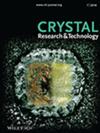合成温度对硫化锰和硫化锌相发育及光学性质的影响
IF 1.9
4区 材料科学
Q3 CRYSTALLOGRAPHY
引用次数: 3
摘要
通过简单的热分解程序制备纳米MnS和ZnS样品。利用X射线衍射图的Rietveld分析研究了合成温度对MnS和ZnS形成的不同相及其百分比、晶格参数和晶粒尺寸的影响。采用本方法制备MnS的最低合成温度为250℃,而ZnS的合成温度较低,为200℃。对于硫化锰,在300℃时出现微量的Mn3O4相,并且随着温度的升高而增加,而ZnS在500℃前抗氧化;在700℃下形成纯ZnO。在所有温度下得到的MnS和ZnS样品都是双相的;立方和六边形。采用高分辨率透射电子显微镜研究了样品的纳米性质和颗粒形态。傅里叶变换红外光谱被用于跟踪两个系统的特征振动带。不同能隙的值取决于晶体的大小、相的百分比和制备温度。MnS和ZnS的光致发光强度和发射颜色与合成温度有关。本文章由计算机程序翻译,如有差异,请以英文原文为准。
Influence of Synthesis Temperature on the Phases Developed and Optical Properties of Manganese Sulfide and Zinc Sulfide
Nano MnS and ZnS samples are prepared through a simple thermolysis procedure. The effect of synthesis temperature on the different phases formed and their percentages, and on the lattice parameters and crystallite size of MnS and ZnS is examined using Rietveld analysis for X‐ray diffraction patterns. The minimum synthesis temperature at which MnS can be formed by the present simple procedure is 250 °C, while ZnS can be prepared at a lower temperature of 200 °C. For manganese sulfide, traces of Mn3O4 phase appear at 300 °C and increase with temperature, while ZnS resists oxidation until 500 °C; pure ZnO forms at 700 °C. The MnS and ZnS samples, obtained at all temperatures, are found to be biphasic; cubic and hexagonal. The nano nature of the samples and the particle morphology are investigated by high‐resolution transmission electron microscopy. Fourier‐transform infrared spectroscopy is applied to follow the characteristic vibration bands in both systems. The values of the different energy gaps depend on the crystallite size, phases’ percentages, and the preparation temperature. The photoluminescence intensity and the emitted colors from MnS and ZnS depend on the synthesis temperature.
求助全文
通过发布文献求助,成功后即可免费获取论文全文。
去求助
来源期刊
自引率
6.70%
发文量
121
审稿时长
1.9 months
期刊介绍:
The journal Crystal Research and Technology is a pure online Journal (since 2012).
Crystal Research and Technology is an international journal examining all aspects of research within experimental, industrial, and theoretical crystallography. The journal covers the relevant aspects of
-crystal growth techniques and phenomena (including bulk growth, thin films)
-modern crystalline materials (e.g. smart materials, nanocrystals, quasicrystals, liquid crystals)
-industrial crystallisation
-application of crystals in materials science, electronics, data storage, and optics
-experimental, simulation and theoretical studies of the structural properties of crystals
-crystallographic computing

 求助内容:
求助内容: 应助结果提醒方式:
应助结果提醒方式:


